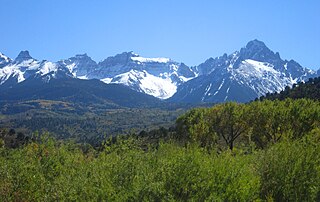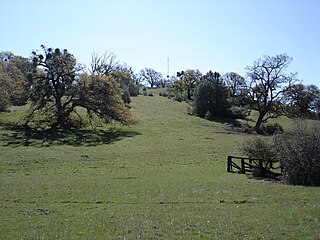
Contra Costa County is located in the state of California in the United States. As of the 2020 census, the population was 1,165,927. The county seat is Martinez. It occupies the northern portion of the East Bay region of the San Francisco Bay Area, and is primarily suburban. The county's name refers to its position on the other side of the bay from San Francisco. Contra Costa County is included in the San Francisco–Oakland–Berkeley, CA Metropolitan Statistical Area.

Mount Diablo is a mountain of the Diablo Range, in Contra Costa County of the eastern San Francisco Bay Area in Northern California. It is south of Clayton and northeast of Danville. It is an isolated upthrust peak of 3,849 feet, visible from most of the San Francisco Bay Area. Mount Diablo appears from many angles to be a double pyramid and has many subsidiary peaks, the largest and closest of which is the other half of the double pyramid, North Peak, nearly as high in elevation at 3,557 feet (1,084 m), and is about one mile northeast of the main summit.

Monument Peak is a mountain peak located southeast of Fremont and northeast of Milpitas in the East Bay region of the San Francisco Bay Area in California.

The Diablo Range is a mountain range in the California Coast Ranges subdivision of the Pacific Coast Ranges in northern California, United States. It stretches from the eastern San Francisco Bay area at its northern end to the Salinas Valley area at its southern end.

Wilson Peak is a 14,023-foot (4,274 m) mountain peak in the U.S. state of Colorado. It is located in the Lizard Head Wilderness of the Uncompahgre National Forest, in the northwestern San Juan Mountains. It is the highest point in San Miguel County.

The community of San Antonio Valley, also called San Antonio or San Antone, is located along the Diablo Range in eastern Santa Clara County, California. The locale is bordered by Alameda County to the north and Stanislaus County to the east. The sparsely populated area is located at the junction of San Antonio Valley Road, Mines Road, and Del Puerto Canyon Road. The area includes the San Antonio Valley Ecological Reserve, a 3,282 acre nature preserve created by a Nature Conservancy purchase of land from local rancher, Keith Hurner, and known for its herd of tule elk.

The Southern Rocky Mountains are a major subregion of the Rocky Mountains of North America located in the southeastern portion of the U.S. state of Wyoming, the central and western portions of Colorado, the northern portion of New Mexico, and extreme eastern portions of Utah. The Southern Rocky Mountains are also commonly known as the Southern Rockies, and since the highest peaks are located in the State of Colorado, they are sometimes known as the Colorado Rockies, although many important ranges and peaks rise in the other three states. The Southern Rockies include the highest mountain ranges of the Rocky Mountains and include all 30 of the highest major peaks of the Rockies.

Mount Stakes is a mountain in the Diablo Range in California. The peak is located on the Santa Clara–Stanislaus county line and is located less than 1 mile north of Henry W. Coe State Park. It rises to an elevation of 3,810 feet (1,161 m) and is the highest point in Stanislaus County. It is 22 miles (35 km) west of Newman and 32 miles (51 km) southeast of Livermore. Some snow falls on the peak during the winter.

Discovery Peak is a peak in the Diablo Range of California and is the highest point in Alameda County. The officially unnamed peak is also known as Valpe Ridge–Rose Flat due to its location near Rose Flat. The area is high enough to receive occasional snowfall during the winter, which generally melts within a few days of falling. Although it is on private property, the Ohlone Wilderness Trail, in Sunol Regional Wilderness, comes to within about 1 mile (1.6 km) of the summit.

Mount Lola is a mountain in the Sierra Nevada of California. Its summit, located north of Donner Pass and Interstate 80, is the highest point in Nevada County. It is also the highest point in the Sierra Nevada north of Interstate 80. A subsidiary peak 1.2 miles (1.9 km) north of the main summit is highest point in Sierra County at 8,848 feet (2,697 m) NAVD 88.
The defunct Boy Scout councils are those which have been closed and merged with other councils.

The SCU Lightning Complex fires were wildfires that burned in the Diablo Range in California in August and September 2020. The fire complex consisted of fires in Santa Clara, Alameda, Contra Costa, San Joaquin, Merced, and Stanislaus counties. The name is derived from the three-letter designation given to the California Department of Forestry and Fire Protection division responsible for the Santa Clara, Alameda, Contra Costa, and parts of San Joaquin and Stanislaus counties, and the complex consisted of several distinct fires occurring in this region.











